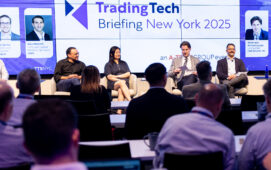Last week, I chaired A-Team’s first Business & Technology of Low-Latency Trading event – #BTLLT for the twittersphere – at The Brewery (a former Whitbread Brewery, it’s now an established events venue), and these are a few geeky highlights from my day.
Starting with the toy I wanted for Easter … it’s called RoboTrader from Actualis, an under-desk full immersion liquid cooled server with two Intel Xeon 5500 or 5600 chips, clocked at an extreme 4.8GHz, and memory up to 128GB. The company reckons that liquid cooling is 1,350 times more efficient than air cooling, allowing the chips to run so fast.
That makes RoboTrader – actually a product of Hardcore Computer, incorporating a motherboard from Supermicro Computer – a meaty device for running quantitative applications, such as pre-trade analytics, and trading model creation. In addition to RoboTrader, Actualis also sells Hardcore/Supermicro-manufactured liquid cooled blade servers, which it dubs Liquid Arbitrage. The wide blades come with fast Intel chips and also optionally with Nvidia Graphics Processing Units (GPUs).
Then, there was the toy I actually received, namely a exact 20 centimetre length of (copper) network cable that represents the distance traveled by electricity through it in a single nanosecond – nanoseconds and measuring them being the current cutting edge of low latency. That was a giveaway from Henry Young of TS-Associates, who led the “Low Latency Over The Horizon” session, which rounded off the long day.
Keeping the tone of the session similar to a Royal Institution lecture, Henry had a couple of interesting and surprising factoids relating to other transmission media. Fibre, it seems, is actually a bit slower than copper: signals can reach just 19.5cm in a nanosecond, though they can be transmitted further than copper without any regeneration.
Faster than today’s network cable, though, is coaxial cable – a real blast from the past (remember original ethernet cabling?) – where a signal can traverse 25.5cm in a nanosecond. Perhaps a little more seriously, David Riddoch from NIC vendor Solarflare Communications cited OS/kernel bypass as the biggest technical advance in reducing latency in recent times, reckoning that server-to-server messaging can now be achieved in 3-4 microseconds, compared to double that for where OS processing is involved.
Independent latency guru Richard Croucher pointed to recent improvements with the Linux operating system, with support of Napi drivers that handle interrupts faster. The latest network switches – with sub-microsecond performance – are also helping to reduce latency across a network. But there was general agreement among the session panelists that leveraging multi-core technology so that several applications run on a single server, with communications via shared memory, will deliver the lowest latency.
The downside of this approach being the relative lack of latency monitoring tools for in-server communications. TS-Associates’ Application Tap is one offering that provides such instrumentation. Looking to the future, the panelists cited leveraging a mix of traditional CPUs, with Field Programmable Gate Arrays and GPUs to optimise performance as one approach with merit.
Also mentioned was the need to embrace parallelism in software, and the difficulty of writing parallel software in current languages, such as C and C++. In that respect, the Erlang language was suggested as a way forward. Sticking his neck out a little, Riddoch suggested that 10gE performance is approaching that of InfiniBand, and one day might even beat it. “Don’t bet against ethernet. It always wins in the end.” I’m not convinced. But we’ll be tracking that at low-latency.com.
Subscribe to our newsletter




